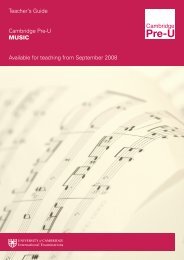Cambridge Pre-U Syllabus - Cambridge International Examinations
Cambridge Pre-U Syllabus - Cambridge International Examinations
Cambridge Pre-U Syllabus - Cambridge International Examinations
Create successful ePaper yourself
Turn your PDF publications into a flip-book with our unique Google optimized e-Paper software.
28<br />
3. ANIMAL PHYSIOLOGY<br />
Section 3 (Animal physiology) and Section 4 (The life of plants) take a look at life in terms of whole<br />
organisms.<br />
<strong>Cambridge</strong> <strong>Pre</strong>-U Draft<br />
Animal physiology explores the different ways in which animals feed, reproduce and transport substances<br />
around their bodies, highlighted by differences due to adaptation and a constantly changing environment.<br />
These questions may be put to candidates to stimulate discussion and prompt and direct their own<br />
researches while covering Section 3.<br />
• Why do large organisms need a transport system?<br />
• How do animals cope with different diets?<br />
• What happens when we age?<br />
• Why do we age?<br />
• How do animals move?<br />
• Why do we need to control internal conditions?<br />
• Why do organ transplants face rejection, but a fetus doesn’t?<br />
• To what extent is the placenta a ‘life support machine’ for a fetus?<br />
• Why sex?<br />
3.1 Transport systems<br />
Content<br />
Structure and function of transport systems in multicellular animals<br />
Ventilation mechanisms<br />
The mammalian circulatory system<br />
Oxygen transport in the blood<br />
Learning outcomes<br />
Candidates should be able to:<br />
a) discuss the impact of size on surface area/volume ratio and the significance of this for animals<br />
b) explain the need for mass flow systems in animals<br />
c) compare ventilation mechanisms and gas exchange in insects, fish and mammals<br />
d) discuss the advantages and disadvantages of:<br />
• open and closed transport systems<br />
• single and double circulatory systems including the increasing complexity and efficiency of<br />
circulatory systems of fish, amphibians and mammals<br />
e) describe the structures and functions, and explain the relationship between structure and function, of:<br />
• mammalian arteries, veins and capillaries<br />
• cellular components of mammalian blood (including erythrocytes, platelets, lymphocytes,<br />
neutrophils, monocytes)<br />
• the mammalian heart – cardiac cycle including pressure changes in the heart, its electrical<br />
coordination and its control by the medulla oblongata in the brain<br />
f) outline the roles of low-density lipoprotein (LDL) and high-density lipoprotein (HDL) in metabolism and<br />
transport of lipids and in atherosclerosis<br />
g) outline the aetiology of coronary heart disease (CHD) as an example of a cardiovascular disease.

















